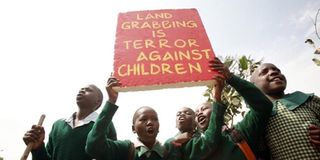Thousands of public schools risk losing land to grabbers

Lang’ata Road Primary School pupils carry a placard during a protest against the grabbing of their school playground on January 19, 2015.
What you need to know:
- About 4,410 schools have title deeds.
- 588 public schools are unsure if they have title deeds or lease certificates.
- SID survey accuses the government of delaying issuance of titles deeds to the schools thus aiding land grabbing.
- There are a total of 29,404 public schools in Kenya, 21,718 are primary schools while the rest are secondary schools.
Some 24, 405 public schools may lose their land to grabbers because they do not have title deeds or lease certificates, a new study has revealed.
And while about 4, 410 have title deeds, 588 public schools are unsure if they have any documents allowing them to possess land on which they sit, according to the survey by the Society for International Development (SID).
The survey released Sunday by Kenya Dialogues Project says lack of land titles exposes the school to encroachment.
The survey, titled One Year on from Lang’ata: Why Public Schools are Still at Risk, singles out local communities at 65 per cent, as the major culprits.
Public institutions are at 18 per cent, religious institutions at 10 per cent, politicians five per cent, Parent Teachers Associations and NGOs 1 per cent each.
On January 19, last year, pupils from the Lang’ata Road Primary School staged protests to reclaim their playground that had been grabbed.
The government had to offer parents an apology later after police tear grassed their children. Police were accused of using excessive force on the young ones.
SID survey accuses the government of delaying issuance of titles deeds to the schools thus aiding land grabbing.
“A year on after President Uhuru Kenyatta’s directive that all public schools must be issued with titles, not one school has received a title or lease certificates in compliance with the January 22 directive,” said associate director of the Kenya Dialogues Project Mr Irungu Houghton.
There are a total of 29,404 public schools in Kenya, 21,718 are primary schools while the rest are secondary schools.
LAND GRABBING REPORTS
The National Land Commission says the titles “should be issued by end of this month”.
An official from the commission Odima Otieno said: “Currently, 2, 400 schools have been surveyed and are waiting for title deeds. This should be done within the next two weeks.”
He said the land agency has received reports from 4,100 schools complaining of land contestation, encroachment and grabbing by third parties.
“Kenyan boys and girls have a right to leisure, play and participation in cultural and artistic activities as enshrined in our constitution,” Mr Otieno said.
The study says six in ten schools have allotment letters, meaning the land on which they sit is public property.
The government gives schools the land on lease hold basis for a specified period of time and subject to specific conditions.
The society has attributed increased interest in land to “fundamental breakdown in the value of public spaces” fuelled by the scarcity of land in urban areas.
“Silence by the public, corruption and collusion of public officials is at the heart of the problem. Administrative delays in implementing the Presidential Directive and community’s inaction have perpetuated the problem,” reads the report.
In the absence of a systematic programme of issuing titles, Mr Houghton says, the public has resorted to protests as was the case with Lang’ata Road Primary School pupils and most recently, Lavington Primary School.
In July last year, 3,475 primary school headteachers from across the country took part in the survey on the state of land in public schools today.
Nearly half of those surveyed came from Kakamega, Makueni, Bungoma, Bomet, Kisumu, Migori, Kericho and Trans Nzoia counties.





